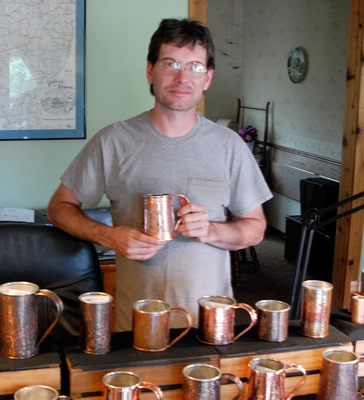Friday, June 24th, 2016
Minster man crafts career making copper drink ware
By Ed Gebert

Photo by Ed Gebert/The Daily Standard
Local copper artisan Brad Cull, Minster, poses with a few samples of his hand-crafted drink ware. Cull uses the technology from the 1700s to make new products, complete with a variety of finishes and etching.
MINSTER - Becoming a coppersmith is not generally a consideration when choosing a career, but Brad Cull has found his niche.
Learning his craft from watching his father, Jim, Cull grew to become a coppersmith - or copper artisan, as he prefers. He took his father's hobby and hammered it into a full-time business.
"I don't do historical reproduction I do more artistic things," he said.
Working with copper is not a common vocation. Cull, himself, knows very few people who work in copper and fewer still who do the work all by hand.
"Everything I do is late 1700s' methods, I just don't use modern technology," he said. "I use a computer in the very early stages of designing something, but once I print out my reference piece, everything is done by hand."
Cull's fascination began in the 1970s as he watched his father create his own pieces. Jim Cull took up the hobby when he decided to make some mugs to match the family's cherished traditional rathskeller cup from the Wooden Shoe Brewery in Minster.
Jim Cull's quest to learn the trade began before how-to books or websites explaining the process were readily available. After a lot of trial and error, he taught himself the process. And through the years, his observant son fell in love with the art.
"Besides gold, it is the only metal that has a color to it. Everything else is a silverish color," Brad Cull explained. "It is also the oldest metal that man discovered, about 10,000 years ago, and it has a unique feel to it when you work it, which I really like."
Copper is a very versatile metal, he noted. Artisans can add color and texture to create something unique.
"There are a lot of aspects to it that I really, really like about copper," he said. "I think it's a unique attachment to an age-old tradition."
Instead of using turning machines, which came along in the 1830s, Cull prefers to use a special hammer to craft his art, a talent he honed with countless projects since he pounded his first tin cup in 2004.
Ten years later, his hobby grew into a business, The Rathskeller Werkes, selling his custom-crafted copper drink ware. He sells at area shows and online at rathskellerwerkes.com. He makes mostly mugs, tumblers and shot glasses, although he had tried a few other items, including a prototype of a copper wine glass.
Cull noted a few coppersmiths work on larger-scale items and a few do smaller-scale items such as jewelry, but he chose drink ware as his niche - hand-crafted drink ware lined with tin.
"Most coppersmiths, the few that you find now, they are focused on certain areas, just because of the skills that are required and the tools that are required and what they are comfortable in doing," he said. "Most coppersmiths that you find now are historical reproductionists, and that's what most people are probably familiar with."
Cull also takes the opportunity to pass along his skills to others, as his father did for him. He recently taught a class for kids through the Lake Area Arts Group at the Chickasaw library.
"How many times do you get to bang a hammer in a library?" he said, laughing. "We made bowls.We hammered these out from just a flat disc of copper and a tree stump and one single hammer. That was a lot of fun. They really enjoyed that."
He admits the kids probably will never catch the fever as he did from his father. Jim Cull still marvels at what his son is able to produce.
"He is amazed," Brad Cull said. "I don't think he ever envisioned it going to this level. He did it as a hobby. He didn't have any intention of making a business out of it."
"For me," he added, "it's always about how far I can push my skills and the medium. How far can you go with it? I fail sometimes, and sometimes I surprise myself."
Cull said the learning never stops, and he likes it that way, making 200-300 pieces each year. He thanks his father for introducing him to the art.
"I've got to give him a lot of credit," he said. "To figure this out on your own, starting with nothing. Even in the old days, they had apprenticeships. He didn't have that luxury. He didn't have anybody to ... ask how you do something. He just made mug after mug and constantly revised and changed.
"I never would have gotten into this if it wasn't for him. I don't think I would have had the fortitude to start with absolutely no knowledge about it whatsoever."


